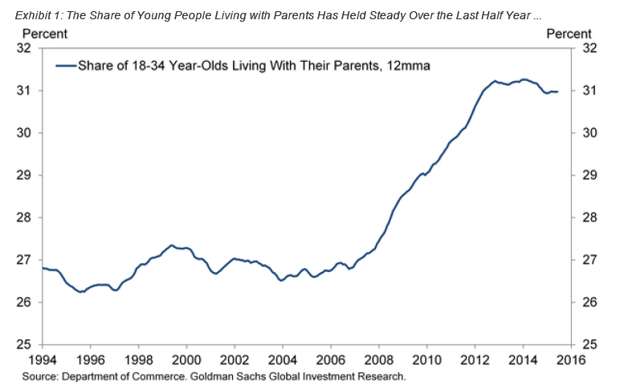This story originally appeared on Citylab.
Recovery or no, the housing news is grim for Millennials. A new report from Goldman Sachs echoes the new findings from the Pew Research Center last month: The economic recovery has not shown any decline in the share of young adults who are living at home with their parents.
Since the start of the recovery (in 2010), the share of 18–34 year-olds who are living at home has, in fact, increased. According to the latest figures, about a third of Millennials are sharing living quarters with their folks. While this percentage stopped growing during the second half of 2014, it hasn’t shown any meaningful shift. Despite the recovery, they’re still stuck.

However, these findings appear to run contrary to a different trend in American housing: The number of new households in the U.S. is rising steadily, according to Census data. Which raises a question: If the percentage of young adults who are living at home with their parents is still so high, how can the number of new households be growing? Who’s forming these new households?
Jed Kolko, an economist, offers up one possible solution. In a report for the University of California-Berkeley’s Terner Center for Housing Innovation, he writes that older adults are responsible for the growth in new households.
"Despite expectations that Millennials are the force behind household formation, older adults are driving household formation. Strikingly, age groups younger than 55 collectively had negative household formation between 2014 and 2015, while 65–74 year-olds accounted for more than two thirds (860,000) of overall household formation."
Kolko compares household formation figures to the unemployment rate: Being employed is like being a homeowner. Being unemployed is like being a renter. Living in another adult’s home, then, is like dropping out of the labor force.
It’s important to distinguish between household formation and “headship rate,” Kolko says. A shift in household formation might sound like a change in how the population lives, but it isn’t necessarily so. Household formation literally means a plus-or-minus change in the number of occupied housing units. (It counts both rental and homeowner units.) The place to look for behavioral change is the headship rate.
This measure reflects the number of adults per occupied housing unit. The headship rate draws on the number of heads of households. The fewer adults in a housing unit, the higher the headship rate. If every adult in America lived alone, the headship rate would be 100 percent. An average of two adults per household means a headship rate of 50 percent.
When you have a growing population and a constant headship rate, that means household formation increases. In that outcome, adults are starting up new households, whether as owners or renters. But when the headship rate grows or declines, it means something’s happening with the way that adults are living.
“The headship rate literally does reflect something behavioral,” Kolko says.
With the economic recovery underway, economists have been predicting a sea change in the housing market. As conditions have improved, Millennials ought to be moving out of their parents’ houses and into new houses—maybe even into homes of their own. But that’s not what’s happening, as the demographic data make clear.
“There is accelerated household formation, but without the behavioral change we expected,” Kolko says.
Instead, there’s a rising share of the population that is moving into an age group that simply has higher headship rates (meaning fewer adults living at home). As more Americans join the ranks of retiring Baby Boomers, more of them are living in households with fewer adults present. Among the fast-rising demographic of retirees, the nests are emptier.
“As the population ages, we will get more households for the given population,” Kolko says. “Even if that’s not a behavioral change within a given age group, it does change overall housing demand. It changes the number of housing units we need.”
There are all sorts of reasons why Millennials aren’t forming new households. Rent-to-income ratios in productive labor markets are at historic highs. Student debt is soaring, and spotty credit ratings might lead to trouble for young adults hoping to strike out on their own, even as the employment situation improves. (Goldman Sachs describes these factors as an explanation for the “excess” of young adults living at home.)
What’s alarming about the fact that so many Millennials cannot leave their parental homes is that they will not necessarily form new households when they do leave them. At least, that’s alarming from an economic standpoint. If and when young adults finally do start to exit their parents’ homes as labor conditions improve, they might still find themselves living with many adults per household in order to make ends meet.
In that scenario, the headship rate—the number of adults sharing a given household—remains unchanged even after young adults leave home. This outcome wouldn’t have a big effect on aggregate housing demand one way or the other. But it might change the kind of housing that the market creates.
“The glass-half-full view is that a big jump in household formation from young adults moving out of their parents’ homes is still to come,” Kolko’s Terner Center report reads. “When this pent-up demand is finally unleashed, it will be in addition to the increase in household formation from the aging population, fueling construction and overall economic growth.”
But, he adds, “the glass-half-empty view is that the drop in headship rates among young adults is not a lingering yet ultimately temporary effect of recession but, rather, a new, lower normal, thanks to rising housing costs, later marriages, and not-good-enough jobs.”